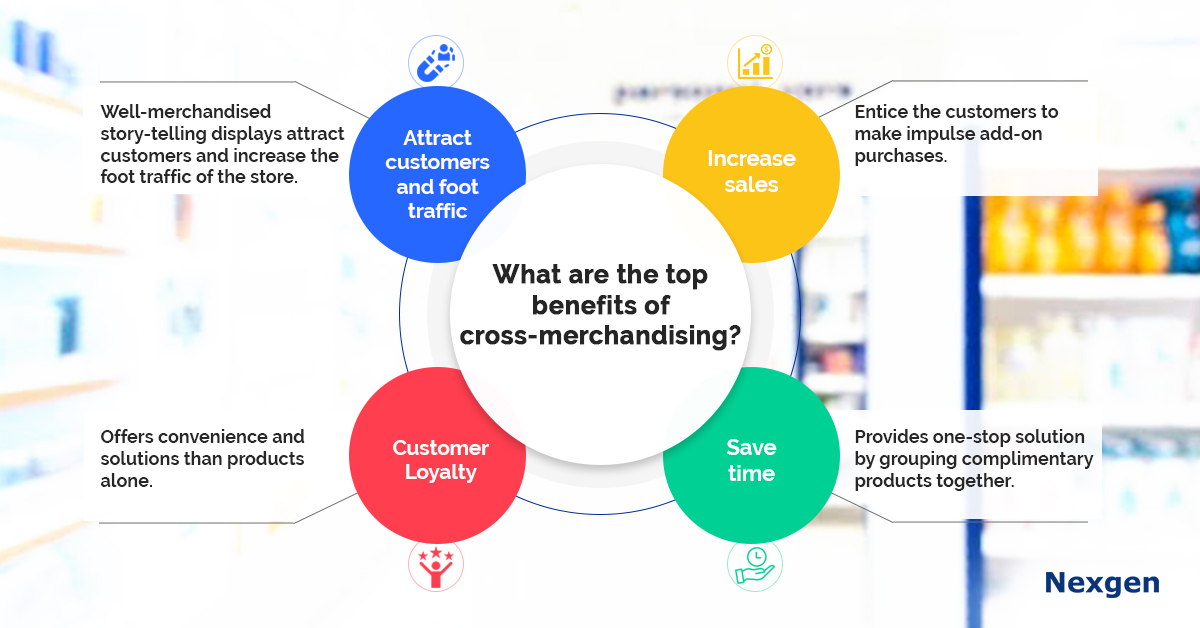The world of retail is changing rapidly like never before. In this digital era, physical retail is more challenging and competitive where they have to compete with online retailers like Amazon.
Implementing compelling blueprints to provide the customers with an immersing shopping experience is the key to keep up the profitability. Merchandising is a valuable tool to influence customer intent and boost sales is indispensable. Cross-merchandising is one such effective merchandising?technique where retailers link products that belong to different categories to offer solutions to buyers while increasing the impulse purchases and additional sales per shopping trip.
Cross- Merchandising
Cross-merchandising is a powerful strategy to stay ahead in this competitive retail landscape where shoppers are seeking an experiential shopping environment. It is a merchandising methodology of arranging products from different categories together. The products placed together shouldn’t be any random products but have some logical connection to prompt the shoppers to make the purchase.
Haven’t you noticed how bread-like products are placed close to the aisle of cheese, peanut butter and other condiments to help remind customers to buy those too at the same time? That’s exactly what cross-merchandising does. It groups products to boost sales and customer experience.
Few classic examples of cross-merchandising are:
-
Ice- creams and ice-cream scoops
-
Beers kept alongside salty snacks, chips or peanuts
-
Placing hard disks with laptops
-
ketchup and mustard next to hamburger buns
-
Dresses, handbags and shoes on the same mannequin
A combination of field marketing and cross-merchandising
You can cross-merchandise successfully during your field marketing campaigns. For example, a baking oven demo with live chocolate cake or cookie baking can remind people about items like cocoa powder, cooking butter, etc which they require to bake one of their own.
Cross-merchandising with an experience
You can also create cross-merchandising strategies based on special occasions For example, when a family plan for a picnic or an outing they indulge in food, beverages, games and they might need comfortable bags to carry them. Displaying associated picnic products together is an experiential solution the retailer can offer. The same goes for hiking, camping, staycation, etc
The unexpected buyer persona
Analyzing your customer behavior helps you to create cross-merchandising displays tailored to their needs. When the shoppers relate to your display and in-store experience more, they are more likely to purchase more and be loyal customers too. A detailed analysis can sometimes reveal unexpected buyer persona which you can utilize to drive more sales. One such is the beer and diaper correlation story known as the folklore of data processing. A detailed sales analysis data of a retail giant revealed one of the most unexpected correlations. Young males who buy diapers also have a proclivity to buy beers, especially on Friday afternoons. When they found out this correlation, they started placing beers near to diapers on Friday evenings and found an exponential increase in sales on both items. Hence detailed buyer persona analysis and continuous evaluation of your sales data analysis can help you make successful cross-merchandising strategies and improve your sales, foot traffic, and customer loyalty.
Advantages of Cross –merchandising
Well merchandised displays can attract customers to the store. Imagine you are planning for a beach vacay. You walk into the store and you are welcomed by a well-organized display of all the essentials for your beach vacay. Such a display draws you into the store it paints a picture of a one-stop solution store in your mind by the way it is cross-merchandised. Such storytelling displays attract customers and increase foot traffic
Cross –merchandising is also known as secondary product placement method. It sends subliminal suggestions to the shoppers that the secondary item goes well with the primary item. This can influence impulse buying and add-on sales and thereby increasing the sales of both products. For example, a black dress displayed together with a matching handbag and shoes can increase the sales of all three items. The shopper who would have thought of only buying the dress may get enticed to see the matching handbag and shoes and might add that too to the cart.

Cross-merchandising is often described as a merchandising technique that offers a solution than products. It helps their meal planning, entertainment experiences and reminds them that they need the other product also to go along. The shoppers today seek conveniences and new experiences. Cross-merchandising done well can give both and help to create a loyalty
In this era of instant solutions, people will appreciate any effort to save their shopping time. Cross-merchandising well –done can save shoppers time by having everything in one place and they don’t have to walk the whole store. For example, ice-creams and ice-cream scoops are generally places on opposite sides of the store. What if they are placed side by side? Shoppers are going to be happy as they don’t have to walk that extra mile. They also remind the customers that they need the other product also and saves their time.
Get your free trial now. Try Nexgen POG for free.